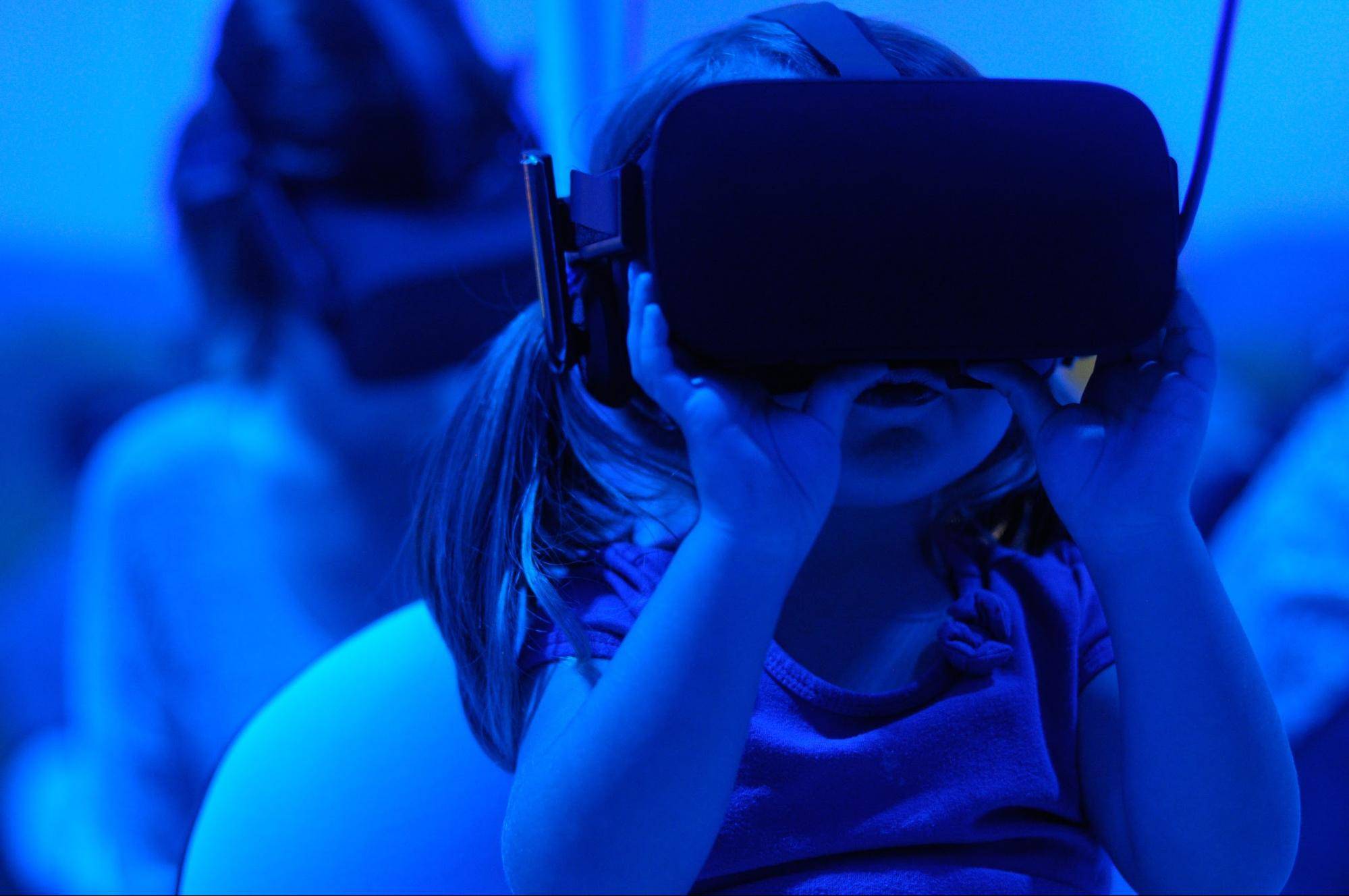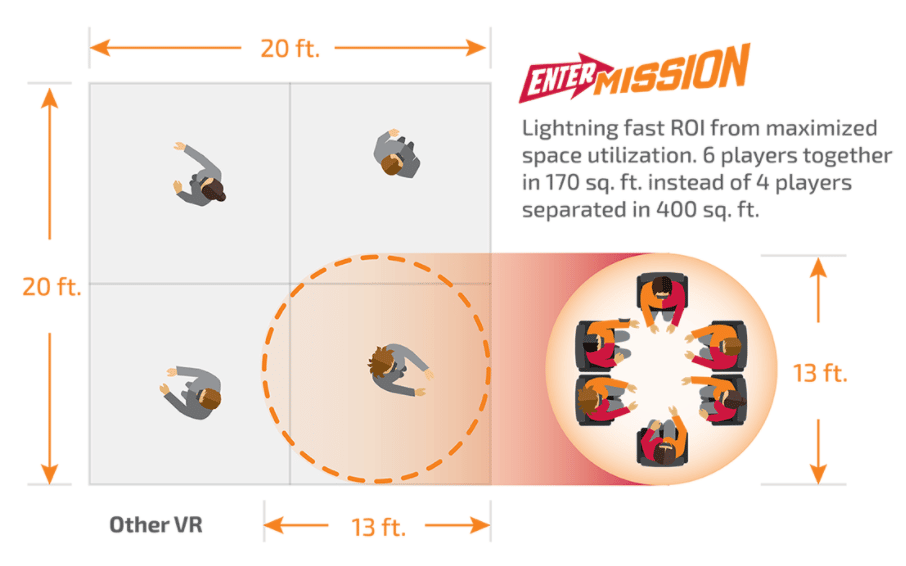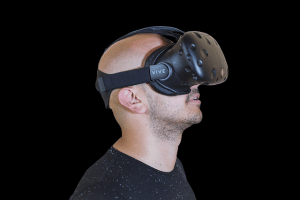The Top 5 Benefits of Adding VR to Your Escape Room
By shrinking space requirements, and providing a comprehensive experience, the VR escape room makes for an eminently sensible addition to your traditional escape room.
Escape rooms are undoubtedly one of the most popular group entertainment options around the world today. For escape room owners, this has been a boon for business.
As more and more people team up to crack clues and solve mysteries, escape rooms owners are seeing their profits shoot up.
But, as with any business, the escape room concept has evolved.
Technology has made it possible to to develop a new kind of escape room, which allows for more players, varied experiences, and an experience that’s a lot more gripping than the traditional escape room.
Who are the news kids on the block?

VR escape rooms.
In this blog, we will explore the 5 top benefits of adding VR to your escape room.
Blog overview
First, we will take a brief look at what a VR escape room is.
Then, we will go over the 5 benefits of adding VR to your escape room. If you want, you can jump to this section.
Finally, we will take a look at what equipment you’ll need to open your own VR escape room.
What is a VR escape room?
VR escape rooms combine the idea of escape rooms with that of a virtual world and the advantages that accompany it.
This may be done via buying outright, or franchising/licensing the VR escape games.
They transport players to unique worlds within which they can play just as well as in physical escape rooms.
But unlike physical escape rooms, virtual reality escape rooms come with the added feature of sensory inputs, like smell, heat, and wind.
In other words,
- VR escape rooms can simulate game situations in a lot more detail than physical escape rooms.
- They can even simulate sensations (like zero gravity) and situations that may be extremely difficult to achieve in a traditional escape room.
- With the added benefit of haptic technology and sensory input, they can offer a much more realistic experience than a traditional escape room.
It’s a pretty safe bet that there WILL be demand from even your regular escape room players for a VR escape room experience.
Let us now take a look at some specific benefits of adding virtual reality to your escape room.

These benefits are based on three features of an VR escape room:
- More efficient space utilization than in a traditional escape room.
- Better and more varied experiences than a traditional escape room.
- Gaining a competitive edge in the industry.
More efficient space utilization than in a traditional escape room
The virtual reality escape game is essentially a computer simulation.
Which means the space required to host a game depends only on the space required to house the VR setup and the players.

It has almost no dependence on the world being portrayed in the game itself, which is a major advantage.
More players can be accommodated at once
In a VR escape room, a lot more players can play the same escape game than in a traditional escape room.
That is because, like I said, VR escape rooms operate in the virtual reality world.
Does that lead to management problems?
Absolutely not.
That’s the beauty of a VR escape room.
More players can play the same space without any problem whatsoever for either them or you and your management team.
This is a direct contrast from physical escape rooms, in which more players sometimes leads to operational problems.
Depending on the space limits of a traditional escape room, you may only be able to host up between 4 and 6 people at a time.
But sometimes, groups of 10 or more people arrive for a game, and they may not appreciate being broken up to experience the game in two separate groups.
VR escape rooms make this a problem of the past.
Thanks to the power of VR tech, all you need is to give the large party group VR glasses to get the party started.
They’ll still need to move around during the game, but will require less space.
Entermission VR escape games, for example, can hold 6 people per 170 square feet.

Now, if you run a traditional escape room, I will wager that 6 people per 170 square feet of room space is a lot higher than your space utilization.
A higher ROI

From the investment point of view, you are more likely to get a higher Return on Investment (ROI) with a VR escape room than if you invest in a physical escape room.
Why?
Well, for three key reasons.
- One is that you will be able to accommodate more players per unit area of the space you’re leasing for your escape room.
Just as we saw earlier.
- Two is that your costs, as in payroll costs and setup costs will be lower.
Since players will either be seated or moving around in a small space, it’s easier to monitor the escape game sessions.
This means fewer games masters required.
Your games require only a VR setup.
This means fewer support staff will be required.
In a traditional escape room, there are so many aspects to watch over - the puzzles, the props, the room design, and so on, which means you’re dependent on various kinds of support staff.
- Three, since you’re offering a much more comprehensive escape experience, backed up by haptics and sensory input, your ratings will go up, attracting more players.
The combination of haptic technology and sensory inputs in a VR escape room can make a sensation of zero gravity in a space station (just taking a random example) very realistic.
Whereas in a traditional escape room, a space station scene could be created via room design, but think how difficult and expensive it would be to simulate zero gravity!
And this wouldn’t be just any escape room but virtually any escape room imaginable, be it a space station, or inside a person’s mind; you name it.
You will also cut the cost of actually setting up the rooms by coordinating the activities of the players remotely using software.
Your main investment would be upfront, in acquisition of the VR hardware and peripherals.
After that, it’s simply a question of acquiring different games software, depending on which games you want your VR escape room to feature.
Finally, this is not simply a matter of cutting costs.
With so many different kinds of games available, backed up by haptics and sensory inputs, your VR escape room will shoot up in the ratings, leading to more bookings.
Smaller spaces can be used satisfactorily

With Virtual reality powered escape rooms, one can utilize a small space to serve all their available clients satisfactorily.
That is because the space you need is limited to setting up VR and other hardware (like the scent and wind generators) and to provide space for players to sit.
For example, in case of Entermission, you need about 170 square feet to house 6 clients.
This is not the case with regular escape rooms where you need real world space comparable with the escape game scenario.
And your players will be just as, or even more, satisfied with the escape game, leading to higher ratings, and more referrals.
Better and more varied experiences than a traditional escape room
Since the entire game takes place in the virtual reality world, you can set up more or less any experience that you want.
Say you want to have an escape game based on a space station.
If you do it in a physical escape room, it means designing an entire escape space with loads of props, careful room design and special effects planning.
For a VR escape room however, it means the same VR setup as with any other VR escape game, only with the space station game uploaded into the server.

It’s almost a ‘plug and play’ situation.
Guests love new experiences which VR escape rooms offer
With the advantage of ‘plug and play’ escape games in VR, you can offer diverse kinds of experiences, incorporating a lot more variety than would be possible in a traditional escape room.
And it’s not only scenarios.
Guests can adopt a myriad of avatars in a VR escape game. They can even do things like shooting lasers, and using telekinesis.
In a traditional escape room, this would be limited to providing costumes for guests, and maybe laser shooters. The effect would be nowhere near that achieved in a VR setup.
The fact that VR uses the ‘Point Of View’ vantage point makes the game experience all the most exciting.
Offering more options and getting repeat players
One of the sustained challenges of a traditional escape room has been getting repeat players.
In other words, say a traditional escape room has two escape games.
The owner has invested extensively in game planning, puzzle creation, and room design and reviews are stellar.
The problem is, however good the rooms are, once a group of players completes both rooms, there’s little chance of them booking again.
Unless of course, more space is hired, and a third escape game added, or an existing game replaced...or the owner hired extra space at the beginning to be able to expand.
All of which are expensive and time-consuming options.
Whereas in a VR escape room, all you need to do is license another game.
While technically speaking they won’t be ‘repeat players’ since you have to add a new game for them to return, the process is so easy you might as well consider them ‘repeat players’.
Gaining a competitive edge in the industry
The escape room industry is becoming increasingly competitive.
A number of markets (like Israel and Poland) have seen net closures of escape rooms over the last couple of years.
Other markets, like the US, have seen some growth, but that’s still net growth, that is, there have been openings, but there have been closures as well.
Maintaining a competitive edge in the industry can be your insurance against being forced into closure.
Adding VR to your escape room
How likely is it that VR escape rooms will completely replace traditional escape rooms?
Not very likely, at least in the near future.
As a thrilling team-based activity, the traditional escape room will have its share of enthusiasts.
However, VR escape rooms are starting to develop a fan base of their own.
People who appreciate a near-total break from their daily lives for a voyage into a dream land where they can fight killer robots and use telekinesis would happily opt for VR escape rooms.
It is this group of escape room players that you can attract by adding VR to your escape room.
And that will give you a leg up over your competitors.
The space required for a VR escape room is so limited, you might be able to set up a VR escape game at your existing (traditional) escape room location.
And then, depending on demand, you can replace your traditional rooms with VR, or rent a fresh location for VR.
Giving players the choice to go for a VR escape room will boost your brand value considerably.
How you can add VR to your escape room
Here’s a brief walkthrough:
- First, choose the developer/distributor from whom you want to acquire the VR games.
- Remember to enquire from the developer/distributor how much space would be required for the VR escape game. For example, Entermission games can fit 6 players in 170 sq. ft.
- Next, find such a space in your escape room location, and turn it into a separate room.
- Third, make a list of the VR hardware and peripherals that will be required, and make a detailed plan of how to install them.
- For example, the VR escape game(s) will require one main server, which will need to be kept in a well-ventilated place to prevent overheating.
- After that comes staffing requirements and hygiene procedures.
- Generally, one games master should be able to handle multiple VR escape games simultaneously.
- Since hardware like the headsets come into direct contact with individual players, they will need to be cleaned after every session.
Conclusion
VR escape rooms are here to stay.
They have several advantages over traditional escape rooms, like
- Better utilization of space.
- Fitting in more players per unit area.
- Helping you make use of even small spaces in your premises.
- Offering diverse, and more comprehensive experiences for players.
- Yielding a higher return on your investment.
- Adding a competitive advantage to your brand.
They’re relatively easy to set up, and you can add VR to your existing escape room location. Which is way better than having to hire a new location right at the beginning.
If you want to add this niche to your escape room, you can check out the best VR escape room franchise in the USA.
Please leave your thoughts and suggestions in the comments below as we are constantly looking for ways to improve this article. Have a great day!
